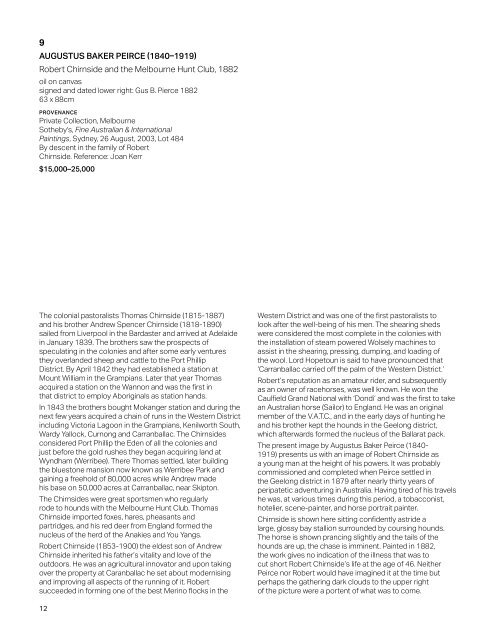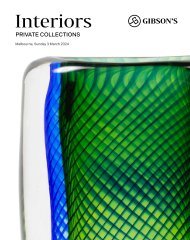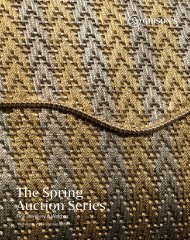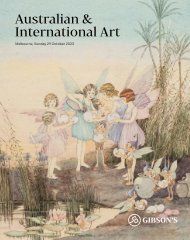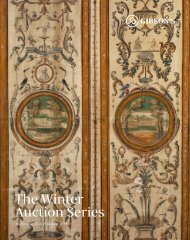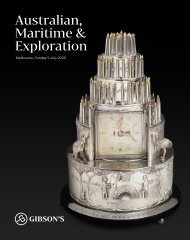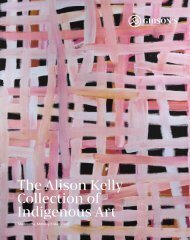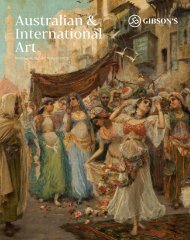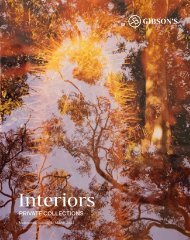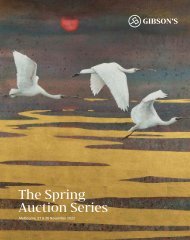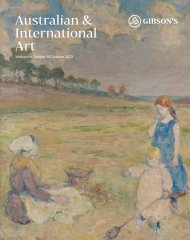The Summer Art Collection
Create successful ePaper yourself
Turn your PDF publications into a flip-book with our unique Google optimized e-Paper software.
9<br />
AUGUSTUS BAKER PEIRCE (1840–1919)<br />
Robert Chirnside and the Melbourne Hunt Club, 1882<br />
oil on canvas<br />
signed and dated lower right: Gus B. Pierce 1882<br />
63 x 88cm<br />
PROVENANCE<br />
Private <strong>Collection</strong>, Melbourne<br />
Sotheby's, Fine Australian & International<br />
Paintings, Sydney, 26 August, 2003, Lot 484<br />
By descent in the family of Robert<br />
Chirnside. Reference: Joan Kerr<br />
$15,000–25,000<br />
<strong>The</strong> colonial pastoralists Thomas Chirnside (1815-1887)<br />
and his brother Andrew Spencer Chirnside (1818-1890)<br />
sailed from Liverpool in the Bardaster and arrived at Adelaide<br />
in January 1839. <strong>The</strong> brothers saw the prospects of<br />
speculating in the colonies and after some early ventures<br />
they overlanded sheep and cattle to the Port Phillip<br />
District. By April 1842 they had established a station at<br />
Mount William in the Grampians. Later that year Thomas<br />
acquired a station on the Wannon and was the first in<br />
that district to employ Aboriginals as station hands.<br />
In 1843 the brothers bought Mokanger station and during the<br />
next few years acquired a chain of runs in the Western District<br />
including Victoria Lagoon in the Grampians, Kenilworth South,<br />
Wardy Yallock, Curnong and Carranballac. <strong>The</strong> Chirnsides<br />
considered Port Phillip the Eden of all the colonies and<br />
just before the gold rushes they began acquiring land at<br />
Wyndham (Werribee). <strong>The</strong>re Thomas settled, later building<br />
the bluestone mansion now known as Werribee Park and<br />
gaining a freehold of 80,000 acres while Andrew made<br />
his base on 50,000 acres at Carranballac, near Skipton.<br />
<strong>The</strong> Chirnsides were great sportsmen who regularly<br />
rode to hounds with the Melbourne Hunt Club. Thomas<br />
Chirnside imported foxes, hares, pheasants and<br />
partridges, and his red deer from England formed the<br />
nucleus of the herd of the Anakies and You Yangs.<br />
Robert Chirnside (1853-1900) the eldest son of Andrew<br />
Chirnside inherited his father’s vitality and love of the<br />
outdoors. He was an agricultural innovator and upon taking<br />
over the property at Caranballac he set about modernising<br />
and improving all aspects of the running of it. Robert<br />
succeeded in forming one of the best Merino flocks in the<br />
Western District and was one of the first pastoralists to<br />
look after the well-being of his men. <strong>The</strong> shearing sheds<br />
were considered the most complete in the colonies with<br />
the installation of steam powered Wolsely machines to<br />
assist in the shearing, pressing, dumping, and loading of<br />
the wool. Lord Hopetoun is said to have pronounced that<br />
‘Carranballac carried off the palm of the Western District.’<br />
Robert’s reputation as an amateur rider, and subsequently<br />
as an owner of racehorses, was well known. He won the<br />
Caulfield Grand National with ‘Dondi’ and was the first to take<br />
an Australian horse (Sailor) to England. He was an original<br />
member of the V.A.T.C., and in the early days of hunting he<br />
and his brother kept the hounds in the Geelong district,<br />
which afterwards formed the nucleus of the Ballarat pack.<br />
<strong>The</strong> present image by Augustus Baker Peirce (1840-<br />
1919) presents us with an image of Robert Chirnside as<br />
a young man at the height of his powers. It was probably<br />
commissioned and completed when Peirce settled in<br />
the Geelong district in 1879 after nearly thirty years of<br />
peripatetic adventuring in Australia. Having tired of his travels<br />
he was, at various times during this period, a tobacconist,<br />
hotelier, scene-painter, and horse portrait painter.<br />
Chirnside is shown here sitting confidently astride a<br />
large, glossy bay stallion surrounded by coursing hounds.<br />
<strong>The</strong> horse is shown prancing slightly and the tails of the<br />
hounds are up, the chase is imminent. Painted in 1882,<br />
the work gives no indication of the illness that was to<br />
cut short Robert Chirnside’s life at the age of 46. Neither<br />
Peirce nor Robert would have imagined it at the time but<br />
perhaps the gathering dark clouds to the upper right<br />
of the picture were a portent of what was to come.<br />
12


